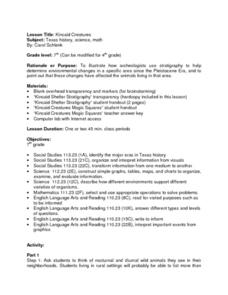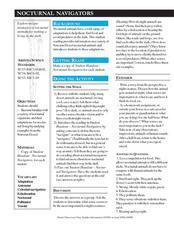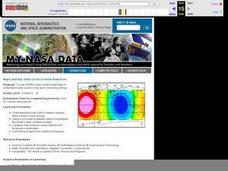Curated OER
Diurnal Temperature Changes and Water Vapor Content
Students examine the greenhouse effect, as they determine how moisture in the air affects the diurnal temperature range. Their investigation help them to explain different climatological regimes of both the Southern Great Plains and the...
Curated OER
Nocturnal vs. Diurnal Animals
First graders identify nocturnal and diurnal animals. In this animal lesson, 1st graders discuss the differences between animals that are active during the day and those that are active at night. Students write summaries about their...
Curated OER
Diurnal Cycling Experiments
Students carry out an experiment to monitor diurnal fluctuations in dissolved oxygen, carbon dioxide, pH, and water temperature. They determine the CO2 and pH of the samples (and optionally, dissolved oxygen). Students complete their...
Curated OER
Tide Types
Students record hourly reading for water height for 24 hours and determine whether a location experiences diurnal, semi-diurnal or mixed tides. Links are present for the information. Students predict high and low tide, and answer a set...
Curated OER
Diurnal Temperature Changes and Water Vapor Content
Students determine how much moisture in the air affects the diurnal temperature range. They investigate to determine the different climatological regimes of both the Southern Plains and the world. and greenhouse gases effect the earth's...
Space Awareness
Day and Night in the World
How do different parts of the world experience day and night? Introduce scholars to the concept of global citizenship while teaching about animal behavior with discussion of nocturnal and diurnal animals. Then, learners complete...
NOAA
Tides
Low tides, high tides, spring tides, neap tides, diurnal tides, semidiurnal tides, mixed tides ... just how many types of tides are there? The 10th installment of a 23-part NOAA Enrichment in Marine sciences and Oceanography (NEMO)...
Curated OER
Venn Diagram
In this science related worksheet, students research animals that are nocturnal (night animals) and diurnal (day animals) and place them in a Venn diagram. Students write characteristics about these animals that are alike, different and...
Curated OER
Animal Behavior
For this grammar and writing worksheet, students use the relative clause "that" to write definitions of words that describe animal behavior. They write definitions for words such as terrestrial, nocturnal, domesticated, and diurnal.
Curated OER
Our Solar System
Students analyze the theories of the formation of the universe and solar system. Students analyze planetary motion and the physical laws that explain that motion: Rotation, Revolution, Apparent diurnal motions of the stars, sun, and...
Curated OER
Kincaid Creatures
Students brainstorm a list of nocturnal and diurnal wild animals they see in their community and discuss how the animals would be different if they were living during the Ice Age. Using a handout, they discover how archeologists record...
Curated OER
What Does It Eat?
Students, working in research teams, investigate the eating habits of crickets. They collect and record data and compare their methods and results with other groups by making tables or graphs. They sumarize their findings with posters or...
Desert Discoveries
Nocturnal Navigators
Young biologists take a look at some of the unique ways that nocturnal animals survive in the dark. After reading a terrific student handout which is embedded in the plan, learners work together to answer questions about what they have...
Wordpress
Darwin’s Natural Selection Case Studies
This editable worksheet is set up so that biology pupils read four case studies and identify points that are present in each, such as overproduction, heritable variation, struggle to survive, and differential reproduction. They also...
Curated OER
NIGHT AND DAY: DAILY CYCLES IN SOLAR RADIATION
Students examine how Earth's rotation causes daily cycles in solar energy using a microset of satellite data to investigate the Earth's daily radiation budget and locating map locations using latitude and longitude coordinates.
Space Awareness
Navigation in the Ancient Mediterranean and Beyond
Ancient texts, like Homer's Odyssey, mentions navigating ships by observing constellations. Pupils learn about the link between history and astronomy as they relate to navigation in the Bronze Age. Scholars complete two hands-on...
Curated OER
Survival Zone: The Intertidal Zone
Students determine water level tidal predictions for a given place for the next month, current status of the area and the local weather. Links are provided for the information. Students answer questions based on the information found,...
Curated OER
Sea Turtles and Nesting Behavior
Students explore the nesting behavior used by sea turtles and explain how these behaviors are beneficial in the survival of a species. They discuss the advantages and disadvantages that sea turtles have be mass nesting. They identify...
Curated OER
Mammals of Fields, Meadows, and Hedgerows
In this mammals worksheet, students research the internet to find information and answer short answer questions about mammals of fields, meadows, and hedgerows. Students complete 12 questions.
Curated OER
Calling All Owls
Students research various types of owls. In this owls lesson, students observe owls and discuss their characteristics. Students go to an owl habitat and listen for the call of an owl. Students read The Owl in the Shower and debate the...
Curated OER
Pika Chew
Students work in collaborative teams with specific roles, use the Internet to research the behavior and ecology of pikas, make predictions about survival rates of pikas in different habitats and organize their data in graphs.
Curated OER
Tides & Lunar Cycles
Young scholars demonstrate how the moon affects the tides, a neap tide, and spring tides by using their bodies as models. After students observe the model they created, they draw and label the diagram on a provided worksheet. They then...
Curated OER
What is a Raptor?
Students explore, analyze and discover the characteristics of raptors and generate a word bank for owls and raptors. They identify attributes shared by raptors and practice various key vocabulary words to master and utilize in sentence...
Curated OER
Amphibians Internet Activity
In this amphibians instructional activity, students click on the links in the questions about amphibians to find the answers to the questions and then come back and answer the questions. Students answer 10 questions total.
Other popular searches
- Diurnal Fluctuations
- Diurnal Temperature
- Nocturnal and Diurnal
- Diurnal Animals
- Dissolved Oxygen Diurnal
- Diurnal Temperature Changes
- Diurnal Planetary Motion
- Nocturnal Diurnal
- Diurnal Motion Sun

























